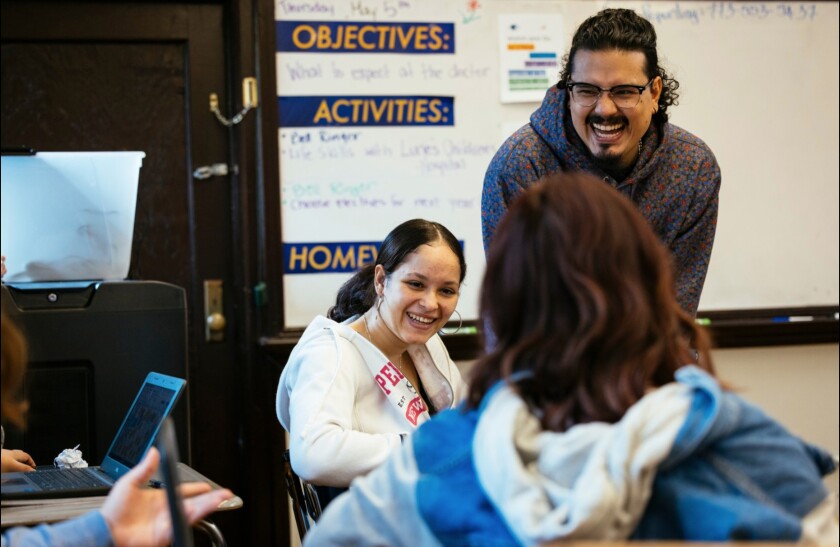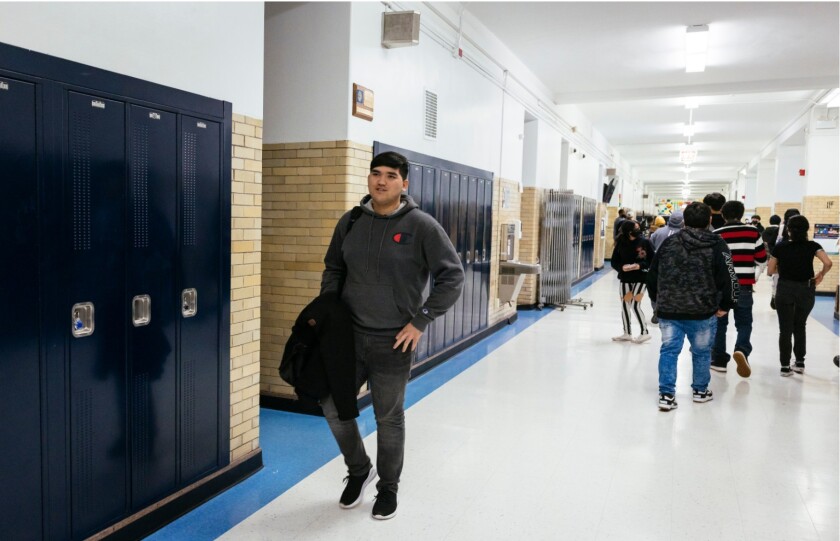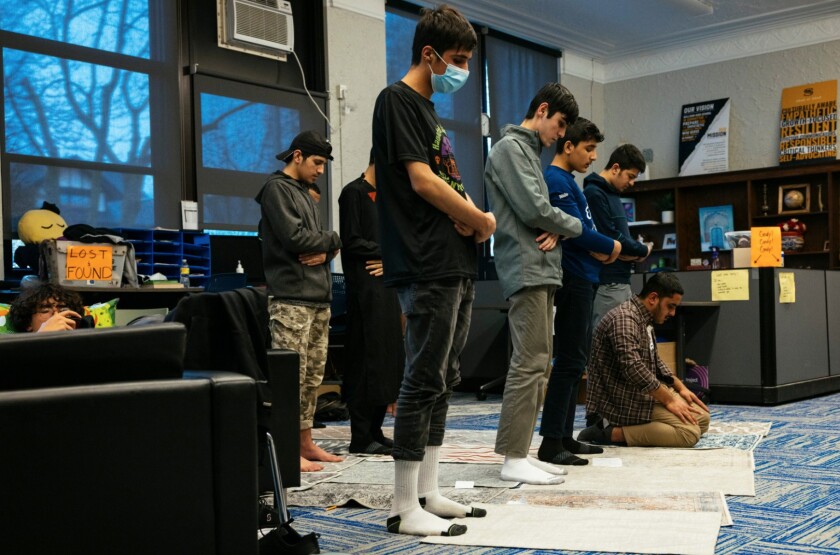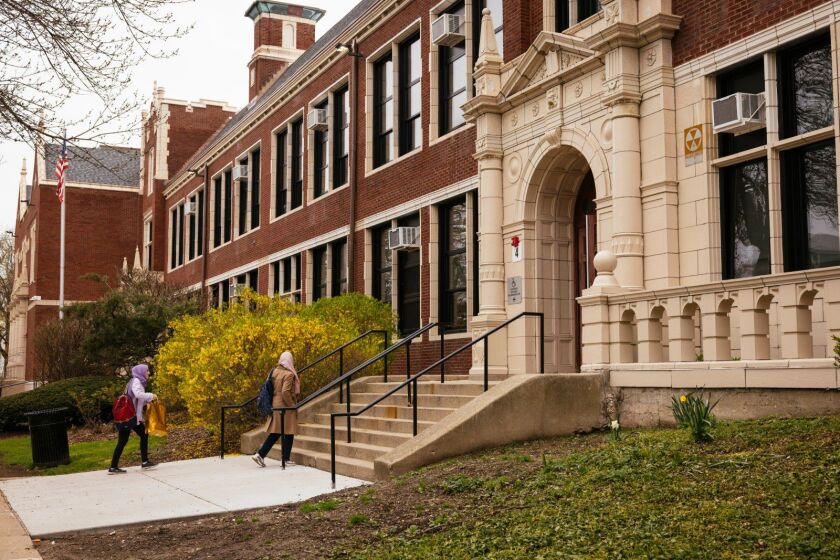Josh Zepeda hopes he’ll get to eat his lunch. It’s just past noon, and he’s yet to have a moment alone.
As he walks to his desk in a back corner of the library at Sullivan High School in Rogers Park, Zepeda, who is in his fourth year as the school’s refugee and immigrant social worker, hears a student call his name.
“Mr. Zepeda!” she yells from the front of the room, her head just inside the door. “There’s some kind of problem. The boys.”
“Great,” Zepeda mumbles. “Of course, there is.”
The girl waves for Zepeda to follow her. When he returns, he’s accompanied by three Afghan students and an American-born Latino boy who is visibly agitated. Zepeda tells the group to sit down on the couches stationed in the center of the room. He turns to the Afghan trio first.
“First things first,” he says, “when there’s a problem . . . ”
“You don’t touch people,” the American-born boy interrupts in a heated tone.
Zepeda turns to the student.
“I’ve been doing this a long time,” he says. “This is not my first rodeo. I got you.”
The truth is that there’s no playbook for this school social worker, who confronts new issues daily as more Afghan refugees arrive. Located in an area of the city with a critical mass of resettlement agencies, this polyglot public school is a landing place for newcomers — more than half of the students are refugees or immigrants.
But the nearly 70 students from Afghanistan who’ve arrived at Sullivan in just a few months present unprecedented challenges not only because of the speed of their arrival but also their disparate needs. Some can’t read and write even in their native languages.
The rapid change has put a strain on the school. Arrival and dismissal routines are crowded, even chaotic affairs. Hallways are packed. Some classes now top 30 students. The need for translators — in person and on language lines that provide services over the phone — has skyrocketed.
So have demands on staff members like Zepeda. And, despite appealing to CPS for more funding midyear, Sullivan has received no additional money.
These challenges are not isolated to Sullivan. With a record 100 million people displaced around the world, including three million Afghans, and war in Ukraine adding to that tally every day, the Rogers Park school faces challenges and transformations similar to those schools and communities across the globe are facing.
Zepeda explains to the Afghan students that, when they have a problem with another student, they need to find an adult in the building to help.
A young Afghan woman tells Zepeda her American classmate took pictures of her without permission.
“Why you do this?” she asks the boy angrily.
“There’s no picture of you,” he says. “I don’t know what the f*** you’re talking about. I was playing games on my phone, and then like 20 of those guys came up and started touching me.”
The two start arguing. Zepeda moves between them, stretching his arms to create a barrier. He’s checked the boy’s phone. There are no pictures. This is a misunderstanding that escalated.
“Everybody is from a different culture,” Zepeda says. “We don’t all speak the same language, and everybody is feeling crazy right now.”
He tells the American student to wait in the back room of the library. As he walks away, the boy shakes his head. “We gotta control these kids,” he says to Zepeda.
Zepeda gives the boy a reassuring pat on the back.
“I want to thank you for holding back today,” he tells him.
The social worker understands the boy’s frustration. The rapid influx of teenagers who speak little to no English, have endured severe trauma and have fled their homes with nearly nothing has been jarring. And that’s for a school that previously has welcomed waves of teenagers fleeing from Syria, Myanmar and the Democratic Republic of the Congo.
He disappears for a few minutes. When he returns, he’s gathered more than 20 Afghan boys. Once they are seated, Zepeda pulls up a chair and says, “We gotta have a talk.”
Everything changed at Sullivan High School last November, when the school began receiving Afghan refugees. Even by Sullivan’s standards, the count was high: 70 new students between November and May.
They’re still coming. By June, administrators predicted, one in seven students at Sullivan would be an Afghan refugee.
While the school year will soon end, most of the students will return to Sullivan in August and find themselves among even more refugee newcomers, some who might be Ukrainian.
The Afghan teenagers are hardly a monolith. Diverse as the school itself, they include students like:
- Omar, who spent most of his childhood in a rural area where he had little formal education.
- Aziz, a junior from Kabul’s upper middle class who fled after the Taliban takeover because of his father’s ties to the American embassy.
- And Sadiya, a sophomore who, after five years in the United States, finds herself helping bridge old and new worlds.
Only the students’ first names are being used here to protect family members still living in Afghanistan who might remain in danger under Taliban rule.
Students come from ethnic groups including Pashtun, Hazara, Tajik, Uzbek and Nuristani, each which speaks its own language and has specific traditions.
Omar, the first to arrive
Omar was the first Afghan student to enroll this year. Sitting in Annmarie Handley’s English Language Learner room with his hair in a high-top fade, he watched as his class ballooned from eight students — four from Central America and South America — to nearly 30.
Omar arrived at Sullivan in November without family and enrolled in school. The 18-year-old had spent most of his life in a rural province, where he worked as a tailor. He fled the country alone.
This morning’s lesson builds on a pronoun unit the class has been working on for a couple of weeks. Omar sits attentively, studying the large television at the front of the room. Handley has put up a projection of her notebook that features a short, simple list: I; You; He, She, It; We; They.
Though learning English grammar is new for Omar, he’s had some exposure to written Pashto.
Not every student in Handley’s class is in such a position.
Sitting across from Omar are three hijabi. They are soft-spoken and spend much of the class huddled together, puzzling their way through the lesson. The young women are among a group of about 10 Afghan refugees who came to Sullivan unable to read or write in any language, including Arabic.
Most are teenage girls from rural provinces where, under Taliban control, access to schools was limited, if not forbidden. Teaching students without any literacy skills presents Handley with challenges.
“It’s like I’m teaching three different classes,” she says.
In response, Handley tapped Rachel Brick, an English and bilingual Spanish teacher, to focus on the students’ specific needs.
Brick exudes optimism. She has spent her career working with students learning English. But, to reach this new set of Afghan teenagers, she’s had to start from scratch.
Normally when Brick would teach the English alphabet, she’d start with a picture dictionary.
“You’d have a ball for the sound ‘buh,’ ” she says. “But these students don’t know the word ‘ball.’ That led me to realize that, if we wanted to support them, I needed to give them something in Pashto.”
With help from an Afghan student, Brick created an English Pashto phonetic picture dictionary that’s six pages long and lists words in Pashto and English for each letter of the alphabet. Brick worked to find words in the two languages that share the same meaning and initial sound. The letter “d” and sound “duh,” for example, is described by the Pashto word “dohl” and “drum” in English.
Brick has encouraged students to say words out loud. She even plays charades with the group to help communicate meaning. But she has never lost sight of the fact that her students are young adults.
“Our students might be emergent in their print literacy, but they know how to read body language,” Brick says. “They know how to read facial expressions. They know how to read the energy of a room. I never wanted them to feel babied.”
For Omar, such attentive instruction is precisely why he keeps showing up at school rather than taking a job. Getting an education, he says, is his priority.
Aziz, alone, piecing together a life
Aziz leans over his backpack, which he’s placed in front of him on the cafeteria table. Like everything the junior now owns, the bag is new. When he arrived in the United States, he came with nothing but the clothes he’d been wearing for nearly two weeks and his passport.
Around him in the school cafeteria, a group of Congolese girls laugh hysterically over a YouTube video. At another table, South American students gossip in rapid-fire Spanish.
Aziz’s table is crowded with Afghan boys who speak in a mix of Pashto and Dari. The table is covered in trays filled with partially eaten chicken nuggets — Sullivan started offering halal meats earlier this year to accommodate the growing number of Muslim students. Several boys sit hunched over their phones, immersed in games of PUBG, the popular mobile battle royale game. A few nurse cans of Monster drinks they bought as part of the celebration of Eid. Others discuss the merits of action movie stars Dwayne Johnson and Keanu Reeves, whose simple language and unhurried speech are well-suited to new English speakers.
Aziz’s life imploded on Aug. 24 when he heard the Taliban had arrived in Kabul.
“We thought it was impossible,” the 18-year-old says. “We thought it was fake.”
But when Aziz rode his bike to school the following day, he saw members of the Taliban lining the streets. He heard gunshots, too. Lots of them. The news, he realized, was real.
The change in regime put Aziz and his family in danger. They immediately decamped for the airport. After hours standing among the crowd outside the building, Aziz lost track of his parents and all but one of his siblings in the chaos.
Aziz had no way to reach his family. An American soldier had pulled him and a brother into the airport, where they eventually boarded a plane.
He didn’t speak with either of his parents until nearly two weeks later, when he arrived at Fort McCoy, the military base in northern Wisconsin transformed into a temporary shelter for Afghan refugees, where he borrowed a phone and learned that his family had not made it out of Kabul.
He and his brother would have to navigate life in America on their own.
“I had such a good life in Afghanistan,” says Aziz, who often looks at photos on his phone that remind him of the world he left behind. “But, in America, I’ve learned that life is not easy.”
In the past few months, Aziz has had to find work at Taco Bell, open a bank account and pay bills. He’s bought all new clothes and furniture and learned to use public transit and cook. So far, he’s mastered pasta and canned beans.
“Being here without my family is very hard,” he says. “I miss them. I came to America with nothing. No house. No money. Nothing. I’ve had to find it all myself.”
Aziz spends each day trying to keep afloat.
He’s not the only one. Many young Afghan refugees made the journey to America alone. Some connect with family members once they arrive in the United States. Others depend on volunteers and resettlement agencies to help rebuild their lives.
“These kids have so many basic needs — clothes, food, internet,” Zepeda says. “We’re just putting out fires left and right. We haven’t even been able to get to the trauma work yet.”
That doesn’t mean students like Aziz aren’t carrying burdens. Nate Sivak, the youth manager for the resettlement agency RefugeeOne, says the trauma many Afghans have faced remains very raw.
“Most refugee populations have time to marinate on the circumstances in a secondary country before coming to the United States,” Sivak says. “But these Afghan refugees are going through that difficult trauma here in Chicago. There’s a lot of grief and disbelief.”
Sadiya, weaving together 2 worlds
Sadiya dressed up for school today. Stepping out into the hallway, the 15-year-old sophomore wears a traditional Afghan dress made of synthetic velvet and chiffon accented with gold details. She’s paired the dress with strappy white sandals and obsidian black lipstick. Much like her chosen outfit, Sadiya walks two worlds at Sullivan.
After resettling in Chicago five years ago, Sadiya speaks near-perfect, accentless English. She knows the latest viral memes and popular TikTok pranks. She sings along to Billie Eilish and Ariana Grande.
Perhaps most importantly, Sadiya understands American school and how to navigate it. That’s why Zepeda tapped her as what he calls a “student guide” for new Afghan arrivals.
Refugee student guides are among Sullivan’s most important tools in supporting newcomers. The goal is to pair each new refugee student with a classmate from a similar background. Zepeda says this one of the best ways to ease students into a new, unfamiliar school environment.
Sadiya has been busy lately. Whenever a new batch of students arrives — which these days is nearly every week — Sadiya shows them how to open lockers and where to find the bathrooms. She also reminds them to respect their teachers and ask for help.
“I tell them Sullivan is a place that will help them with their future,” Sadiya says. “That it’s a good school where they’ll make a lot of friends.”
Still, despite acclimating to American life, Sadiya has never quite felt at home herself. Not until the latest crop of Afghan students started to arrive.
“They just understand me in a way my American friends never did,” she says. “We talk about missing home and our families and what it’s like to feel like you’re in two different places. We’re there for each other. We’re like a family now.”
Says Zepeda: “She understands both cultures. It’s huge.”
Balancing the expectations of a public, secular American school while honoring cultural and religious traditions is a constant negotiation at Sullivan. Even students like Sadiya can’t bridge every divide.
Take Ramadan, the most holy month of the year in the Muslim faith. After granting the boys a space to pray during the school’s seventh period, staff members noticed that daily prayer was taking longer and causing students to miss more class time.
“I understand that prayer is hugely important,” says Zepeda, who has prayed with the boys on occasion. “But, as soon as they start taking advantage of the situation or lying to me about it, that’s when we have a problem.”
After several conversations between staff and students, Sullivan staff brought in a respected member of the Afghan community to help resolve the situation. Now, the boys take 15 minutes to pray and are back in class.
“When a big group of students arrive so quickly, there are going to be these kinds of clashes,” Sivak says. “It’s important to be thoughtful about such a sensitive topic. But I also think you have to ask: ‘Are these behaviors coming from a Muslim or from a teenager?’ ”
Back in the library, Zepeda has spent the last 10 minutes trying to sort out the events that led to the threat of a fight between Afghan boys and another group of students. One Afghan boy says the whole thing is a misunderstanding. Another says they were approached first. A third plays dumb. The rest say nothing.
“OK,” Zepeda says, frustrated. “I’m going to check the security tape. If you weren’t involved, you can leave.”
When Zepeda returns, he describes seeing on the tape five Afghan boys zeroing in on the one American-born student. One, in a fit of dramatic flair, jumped over a table.
“You guys turn a little problem into a big problem,” Zepeda says, raising his voice. “You cannot do that. There are certain things in this culture in Chicago that you don’t understand. You guys need to relax. You are asking for a fight.”
When Zepeda finishes, he tells them to return to the library at the end of the school day. He wants to shepherd the boys out of the building to avoid another potential blowup.
When the final bell rings a couple of hours later, the teens obediently return. Zepeda keeps the Afghan boys until nearly 4 p.m. to ensure the block is clear when they exit the building.
Zepeda can’t control what happens outside the halls of Sullivan but says he needs tolerance and empathy from the community the Afghan teenagers are entering. That’s one reason he encourages students to connect with neighbors and take jobs at local businesses.
He also runs summer programs like one called Discover Chicago to introduce refugees to the city — and, in some ways, to introduce the city to its newest residents. To successfully integrate refugee students, Zepeda, and Sullivan, cannot operate in isolation.
As the exhausted social worker walks the students out of the building, he shares one last piece of advice:
“Don’t do anything stupid.”
It’s advice he will continue to give as long as the boys keep showing up for school.
Elly Fishman is a freelance writer and author of “Refugee High: Coming of Age in America.” Follow her @elly33.

















